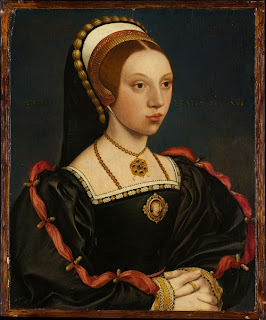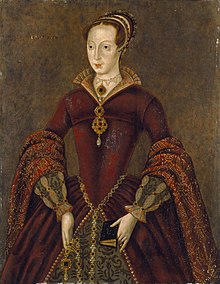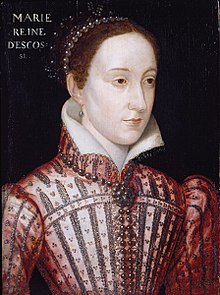
Above: Katherine Howard - trendsetter and fashion lover?
Cleopatra, Anne Boleyn, Elizabeth I, Marie Antoinette - all were fashion-loving queens who emerged as trendsetters at their respective courts, evoking glamour, sophistication and originality into the costumes they eagerly wore as symbols of their power and influence. Katherine Howard, the short-reigning fifth queen consort of Henry VIII, is not typically included amongst these royal fashion legends. But interestingly enough, tantalising glimpses within the sources indicate that this queen was a woman who loved fashion, and who stood out amongst Henry's wives (with the possible, obvious exception of her French-fashion loving cousin Anne Boleyn) for her delight and love of fashion. Observers who met Queen Katherine focused, above all, on her dress in their writings, ranging from the appreciative comments of the French ambassador, who met her in the glorious days of her honeymoon in the late summer of 1540, that she had taken to wearing French clothes, to the Imperial ambassador's recollection that she had been wearing a gown of black velvet when she was taken to the Tower of London barely eighteen months later.
A range of evidence offers compelling insights into Katherine's love of fashion. In September 1540, just two months after she had married Henry VIII, the French ambassador Charles Marillac visited her while the court was on progress. Although he found her to be graceful, rather than beautiful, Marillac appreciatively noted that she had dressed both herself and her ladies in the latest and most becoming French fashions. An insight into how Katherine might have looked in her stunning French gowns at the time Marillac met her can be discerned in the portrait miniature below, believed to be of the Queen:

As Susan James comments, the fur-trimmed sleeves worn in the miniature alongside the jewelled bodice and cap of matching material in brown indicates that the portrait was painted in the autumn or winter. If it is a portrait of Katherine, therefore (and there is some doubt about this), it might reasonably therefore be suggested that the queen sat for this miniature between September 1540 and February 1541, around the time that the French ambassador met her personally and commented on her love of French fashion. Although Susan James, in her article, suggests that the miniature is actually a portrait of Lady Margaret Douglas, a niece of Henry VIII, the emerald and ruby pendant worn by the sitter is a jewel that had previously been worn by Jane Seymour, Katherine's predecessor. The queen's jewels were worn by the women who occupied that role, and following Jane's death, her jewellery would have passed to Katherine to wear.
The notorious Chronicle of King Henry VIII of England, more commonly known as The Spanish Chronicle, was written by an unknown Spaniard in the mid-sixteenth century, and has been derided by historians for its inaccuracies and sensationalised nature. Interestingly, however, this account provides further insights into Katherine Howard's love of fashion, and suggests that this love was known beyond the confines of the court. Just as Katherine of Aragon was revered for her piety, and Anne Boleyn famed for her interests in theology and music, so, too, might Katherine Howard have come to be associated with elegant and glamorous dress. The author wrote: 'The King had no wife who made him spend so much money in dresses and jewels as she did, who every day had some fresh caprice'. It is a comment that could easily be written about the likes of Marie Antoinette. Add this remark to Ambassador Marillac's comments and a clear picture emerges of a fashion-loving queen famed for her love of luxurious and expensive dress.

Above: Queen Katherine, teenage queen and fashion lover. One observer wrote of the fifth queen: 'The King had no wife who made him spend so much money in dresses and jewels as she did, who every day had some fresh caprice'.
But if Katherine loved adorning herself in the finest of fabrics and the most dazzling of jewels, she was ready and willing to impart that love to others and share it with them. A look at her inventory demonstrates this, and suggests a kind-hearted and caring girl who wanted others to love fashion in the same way in which she did. Katherine bestowed upon her two stepdaughters, the twenty-four year old Mary and the seven-year old Elizabeth, gifts of jewellery, including a pomander of gold with rubies and pearls, and she was also to grant her former mistress and predecessor, the rejected Anne of Cleves, a ring. More famously still, according to the Proceedings of the Privy Council, upon hearing of the news of the aged Countess of Salisbury's imprisonment in the Tower in the spring of 1541, the queen ordered her tailor to provide the aged prisoner with a furred nightgown, a furred petticoat, a kirtle, a nightgown, a frontlet, four pairs of hose, four pairs of shoes, and one pair of slippers. Tragically, the 68-year old noblewoman was bloodthirstily beheaded in May 1541, but one would hope that Katherine's gifts of clothing would have provided her with at least some comfort.

Above: Margaret Pole, countess of Salisbury (left), and Mary Tudor, later queen of England (right), were two women who experienced Katherine Howard's inordinate love of fashion.
The last few months of Katherine's life offer final tantalising glimpses into the close associations she was clearly felt to possess with fashion. Upon being imprisoned in Syon Abbey in November 1541, it was specifically ordered that her clothing should only be plain, and her French hoods should contain no jewels. Just as her expensive and lavish French fashion and royal jewellery had demonstrated her power and legitimacy as the beloved consort of the King in the times of her queenship, so, too, did Katherine's downgraded fashion demonstrate visibly her disgrace and disfavour. Upon being taken to the Tower in February 1542, the Imperial ambassador felt it apt to record that the queen, she who had once taken such pride in French designs and glittering jewels, was merely wearing a gown of black velvet. This fashion choice may have been a calculated move on Katherine's part, allowing for a measure of dignity and a suggestion of the gravity of her situation, or it may merely have reflected the limited array of clothing she now had at her disposal.
It is uncertain what Katherine wore on the scaffold, for no contemporary observers felt it necessary to record what she wore - a somewhat surprising omission, given that this article has suggested that her associations with, and love of, fashion were well known. Disgraced Tudor queens about to die on the scaffold had something of a habit for utilising fashion to make a final and compelling statement to the assembled audience. We know that Queen Anne Boleyn had wore an elegant gown of grey damask with a crimson kirtle underneath and a mantle trimmed with ermine. These represented two conscious and clever fashion choices on the part of the queen. Crimson, as Alison Weir notes, was the Catholic colour of martyrdom, so by wearing it, Queen Anne was effectively proclaiming her innocence and martyrdom in the most visible means possible. Secondly, her ermine mantle, a fur only worn by the royalty, represented her position as queen to the very last. In so doing, Anne died proclaiming both her innocence and her royalty. Similarly, in 1587, Mary Queen of Scots selected a red costume to wear to her execution, in a calculated effort to emphasise her martyrdom and innocence.
Queen Jane Grey, on the other hand, chose to wore a gown of black, probably the same which she had worn to her public trial three months previously. Of course, in Delaroche's famous painting of 1833, the teenage Queen is replete in white costume, emphasising her innocence, fragility, and martyrdom. But this painting is steeped in inaccuracies. The real Jane wore black to the scaffold. Couple this fashion choice with her devout Protestant faith, so evident in the last days of her life, and a clear picture emerges of a woman determined to emphasise her sobriety, earnestness, piety and dignity to the last, dying in her faith. Just as Anne Boleyn chose to celebrate her innocence and royalty on the scaffold, Jane Grey focused on her Protestant faith and dignity, while Mary Queen of Scots' red costume declared her martyrdom and death in the Catholic faith.



Above: Three other beheaded queens - Anne Boleyn, Jane Grey and Mary Stuart - made calculated choices in their outfits on the scaffold, employing fashion to offer a final and compelling statement.
By contrast to her fellow executed queens, we have no way of knowing what Katherine Howard wore to her execution. It may well have been the black velvet dress she wore on her journey to the Tower, spotted by Ambassador Chapuys. It is somewhat ironic that, for a woman clearly besotted with fashion, it is unknown what she wore on the final, and most dramatic, day of her short-lived life.
Despite this tantalising omission, the fragments available from surviving sources convincingly suggest that Katherine was a fashion-loving queen who may have acted as something of a trendsetter at the English court. She did not revolutionise fashion, in the way in which the likes of Elizabeth I and Marie Antoinette were to do, but she revelled in it and clearly wished to impart that passion to other members of her court. Often dismissed as frivolous and empty-headed, Katherine may actually have been using fashion in a more clever and calculated effort to enhance and celebrate the prestige and power of the Tudor dynasty, by appearing well-dressed, spectacular, and mesmerising at the side of her husband, Henry VIII, a man who, of course, was well known for his love of splendour and glory.
No comments:
Post a Comment